Physical Address
304 North Cardinal St.
Dorchester Center, MA 02124
First reported by Vater and Ezler in 1723, bile duct cysts represent a rare pathology. They exist most commonly as a pediatric surgical problem. The majority of bile duct cysts are diagnosed in infants and children within the first decade of life, and an estimated 25% are detected by 1 year of age with an additional 35% to 55% by the age of 10 years. Presentation occurs in adulthood in approximately 25% of patients. , Although clinically similar, the presentation and therapeutic strategies for bile duct cysts in adults differ substantially from those of younger patients. In contrast to the pediatric experience, adult patients have an increased rate of acute presentation with biliary and/or pancreatic symptoms, are more commonly associated with hepatobiliary pathology, and they are often first seen with complications of previous cyst-related procedures. , The surgical management of bile duct cysts in adults is therefore complicated by co-existing hepatobiliary disease and the added technical difficulties of reoperative biliary surgery. Despite the heterogeneity of the disease and the absence of clinical trials, a collective consensus for excision of extrahepatic bile duct cysts has been generally accepted. However, the management of intrahepatic bile duct cysts remains controversial and the method of choice for reestablishing bilioenteric continuity after excision is debatable. This chapter examines the spectrum of hepatobiliary pathology encountered in adults with bile duct cysts and describes the surgical approaches for managing such patients.
Bile duct cysts are classified according to their anatomic distribution within the biliary ductal system as well as the extent and morphology of the cystic anomaly. Although the term choledochal cyst is often used, bile duct or biliary cyst semantically is more appropriate because cystic dilation can occur anywhere throughout the biliary ductal system, not only within the common bile duct (CBD; choledochus). The first systematic classification of extrahepatic bile duct cysts was proposed by Alonso-Lej and colleagues in 1959 in which cysts were classified into three types. Although this classification did not include intrahepatic bile duct cysts, this simple and practical scheme has provided the basis for all other classification systems. Interestingly, the size of the dilation of bile duct to qualify as “cystic” dilation has not been defined clearly by either absolute size (diameter in millimeter) or ratio of measured-to-expected duct size at the cyst site in the biliary tree. Lack of specific criteria for defining bile duct cysts can be difficult clinically, particularly in patients after cholecystectomy, in whom the extrahepatic bile duct dilates as a physiologic response to an intact sphincter of Oddi. Whether secondary cystic dilation of bile ducts has the same clinicopathologic consequences and requires similar operative management is unknown. Operative intervention in these patients is avoided, unless symptoms develop.
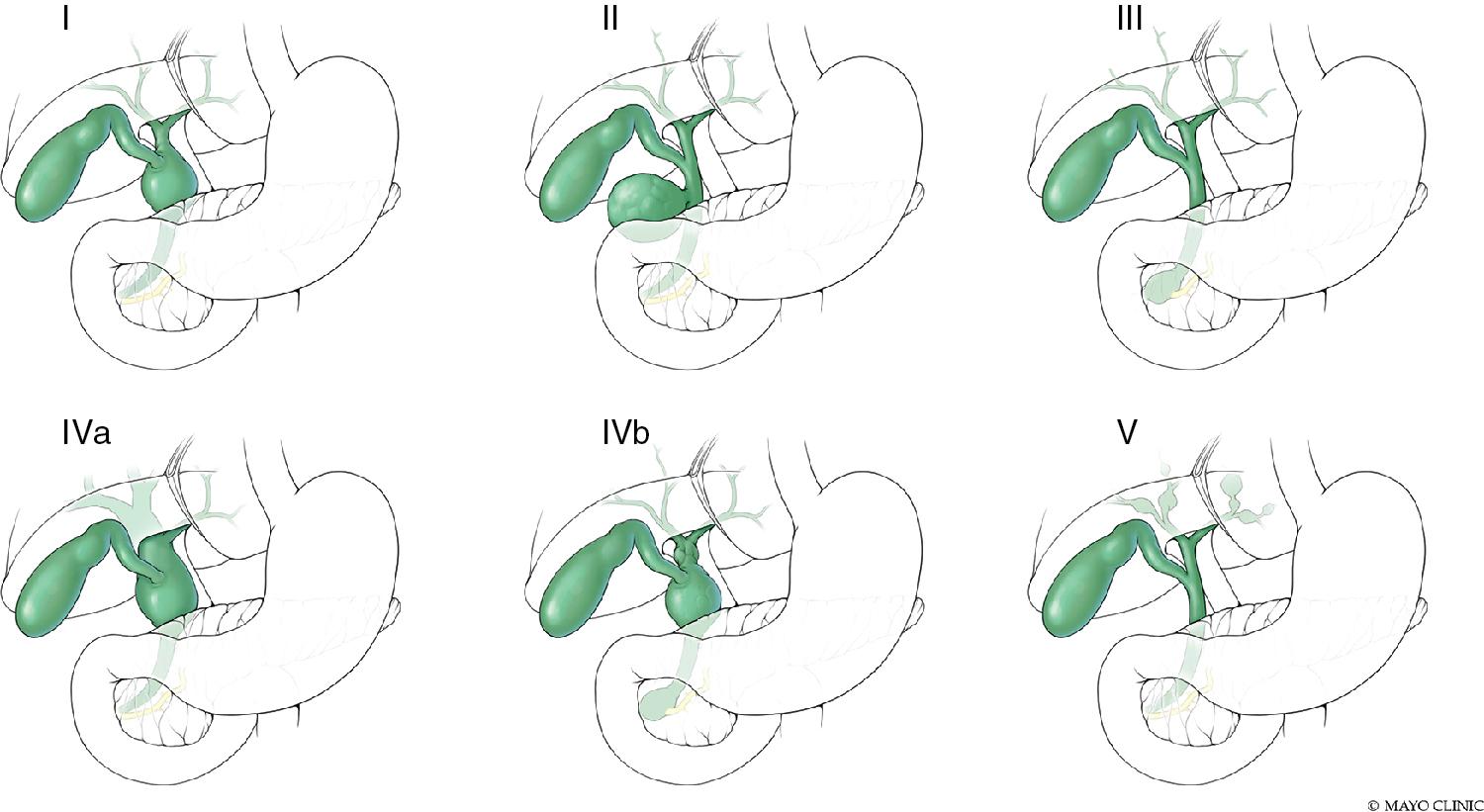
In 1958 Caroli and colleagues described the entity of “multiple intrahepatic bile duct cysts.” The recognition of intrahepatic bile duct cysts led to modification of the original classification system. In 1977 Todani refined the classification system of bile duct cysts by combining the Alonso-Lej classification and the variants of Caroli disease. The classification system was further expanded on in 2003 to incorporate the presence of an anomalous pancreaticobiliary junction (APBJ) (see Chapter 2 ).
Type I cysts are solitary fusiform or saccular dilations of the CBD and common hepatic duct (CHD). The CHD proximal to the cyst and ductal confluence is normal. Type I cysts are the most common bile duct cyst, comprising 50% to 90% of cysts and are subclassified further according to anatomic extent. ,
Type IA cysts are the most common subtype and are associated with an APBJ. They involve cystic dilation of the CBD and the CHD and may extend to the extrahepatic right or left hepatic ducts. The cystic duct and gallbladder arise from the cyst.
Type IB cysts demonstrate focal, segmental dilation of the extrahepatic bile duct, most commonly involving the distal CBD and are not associated with an APBJ.
Type IC refers to a smooth, fusiform, diffuse, or cylindrical dilatation of the extrahepatic ducts and are associated with an APBJ. Typically, the dilation extends from the pancreatobiliary junction to the CHD or extrahepatic main left and right hepatic ducts.
Type ID cyst is a recently proposed modification of the Todani classification. , They are characterized by dilation of the cystic duct as well as CBD and CHD, resulting in a bicornal configuration of the cyst. An association with an APBJ has not been defined.
Type II bile duct cysts occur in approximately 2% to 3% of patients. , They are a discrete, true diverticulum of the extrahepatic bile duct system. They often project off the right lateral side of the bile duct and can resemble a duplication of the gallbladder. Approximately 60% are located between the CHD and biliary bifurcation, whereas 20% arise from the suprapancreatic CBD and another 20% from the intrapancreatic portion of the CBD.
Type III cysts comprise 1% to 6% of bile ducts cysts and are characterized by cystic dilation of the intraduodenal portion of the distal CBD. , , They are also referred to as choledochoceles. Type III cysts may represent a disparate disease entity and can be lined by duodenal or biliary epithelium. Type III cysts are more likely to be encountered incidentally during endoscopic retrograde cholangiopancreatography (ERCP) and are managed primarily with endoscopic therapy. Pancreatitis is often seen with type III cysts, whereas biliary tract symptoms are less common. They are commonly divided into two subtypes based on their anatomic morphology. , Type A choledochoceles are cystic dilatations of a segment of the intramural bile duct. The bile duct and pancreatic duct enter the cyst and the cyst communicates with the duodenum at a separate orifice. Type B choledochoceles are diverticula of the intraampullary common channel. The bile duct opens normally into the duodenum.
Type IV cysts are the second most common subtype, comprising 15% to 35% of all cysts. They are defined by the presence of multiple cysts and can be stratified by intrahepatic bile duct involvement. Type IVa is the most prevalent and involves multiple cysts in both the intrahepatic and extrahepatic bile ducts ( Fig. 46.2 ). Intrahepatic dilation can affect both lobes, although the left lobe is predominantly involved. Isolated dilation within the right liver is rare. A primary hilar stricture or discrete change in duct caliber at the hilum may be seen. Type IVb, by contrast, consists of multiple dilations of the extrahepatic biliary tree with an uninvolved intrahepatic biliary tree. It is classically described as having a “string-of-beads” configuration.
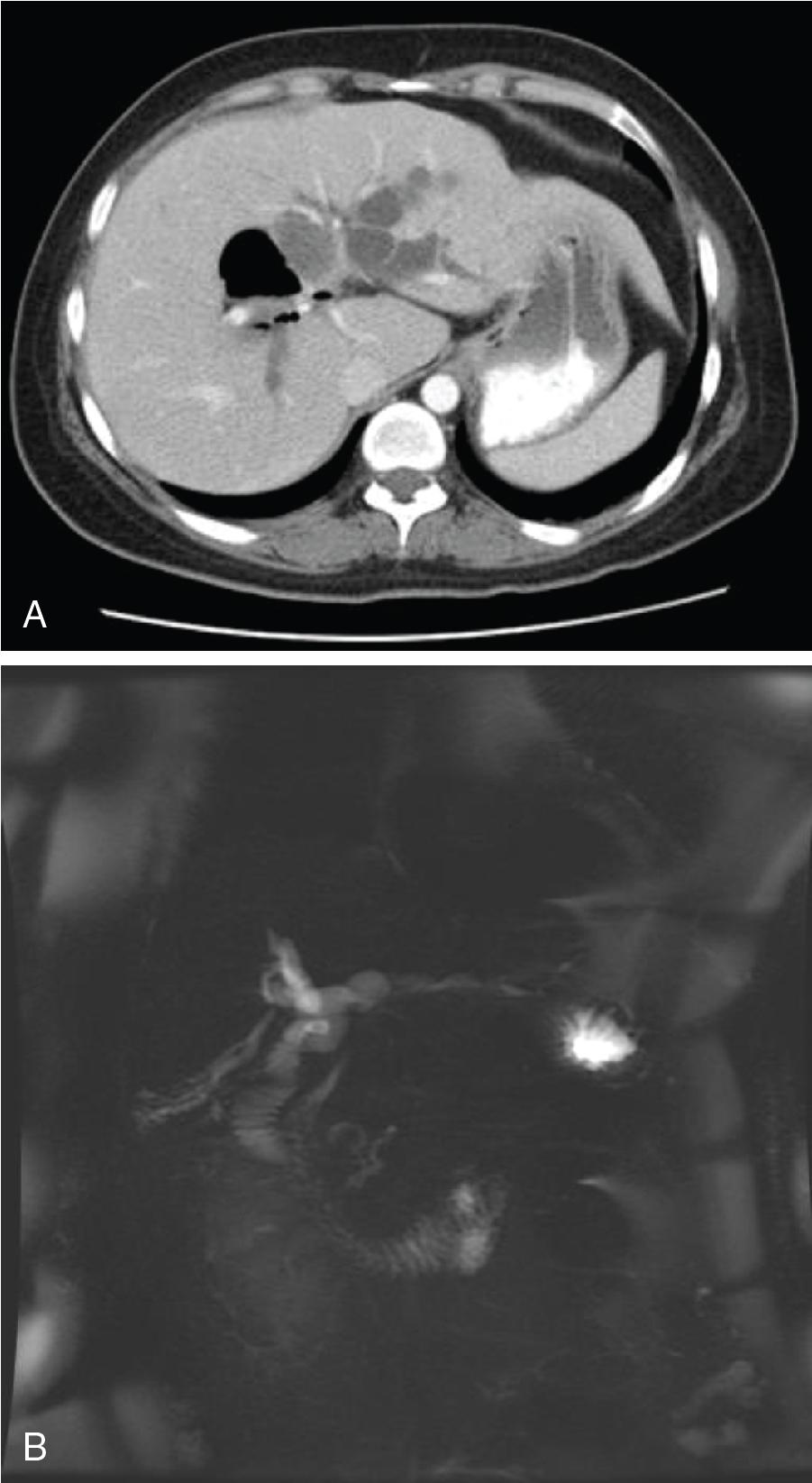
Last, type V cysts are characterized by one or more saccular or fusiform dilations of the medium- and large-sized intrahepatic ducts with no underlying obstruction or extrahepatic ductal system involvement. This entity is also known as Caroli disease, or communicating cavernous ectasia, and accounts for up to 20% of bile duct cysts. When type V bile duct cysts are associated with congenital hepatic fibrosis, the condition is termed Caroli syndrome or Grumbach disease. Specifically, Caroli syndrome is characterized by the presence of intrahepatic ductal ectasia and periportal fibrosis. Both Caroli disease and syndrome have been described as inheritable in an autosomal recessive pattern and may be associated with autosomal recessive polycystic kidney disease as well as other hepatorenal fibrocystic diseases.
A type VI bile duct cyst has recently been proposed and is characterized by an isolated dilation of the cystic duct in the absence of CBD or CHD involvement. This finding is quite rare and limited to a few case reports. ,
Forme fruste bile duct cyst (an atypical or attenuated manifestation of a disease process) is simply a normal biliary ductal system associated with an APBJ. Patients present with typical symptoms of abdominal pain and obstructive jaundice. A predisposition to recurrent pancreatitis is present. Similar evidence of histologic inflammatory change and malignant potential has been described; thus some authors have posited inclusion of this entity in the spectrum of bile duct cysts.
Matsumoto also modified the Alonso-Lej classification system based on adding configuration to the location of the cysts. Clinical management of bile duct cysts is dictated by cyst location, not configuration. Indeed, no data have shown clinical differences in presentation for similar type cysts with varying configurations. Therefore this subtyping has limited clinical utility. ,
There are advantages and disadvantages to the increasingly complex alphanumeric modifications of the widely used Todani classification. Although the principle critique of the original Todani classification is that multiple distinct subtypes have been consolidated, whether the anatomic subtypes differ with respect to pathogenesis, natural history, clinical management, associated hepatobiliary pathology, and complication profile remains unclear. Additionally, mixed or variant types of cysts exist and are unclassifiable by the Todani classification (see Fig. 46.1 ). Visser and colleague’s recent recommendation for descriptive terminology alone in lieu of Todani classification, although more exact, may provide clinical evidence for the value of subtyping.
A single mechanism for the pathogenesis of bile duct cysts is unlikely because bile duct cysts represent a spectrum of distinct anatomic subtypes. Bile duct cysts may be either congenital or acquired. Both environmental and genetic factors have been postulated. Moreover, the increased incidence is predominant in Asian populations with rare reports of familial inheritance. , , Bile duct cysts have been associated with numerous developmental anomalies including biliary atresia, duodenal atresia, colonic atresia, imperforate anus, pancreatic arteriovenous malformation, multiseptated gallbladder, OMENS (orbital, mandibular, ear, neural, and soft tissue) plus syndrome, ventricular septal defect, aortic hypoplasia, congenital absence of the portal vein, heterotopic pancreatic tissue, familial adenomatous polyposis, and autosomal recessive and autosomal dominant polycystic kidney disease (see Chapter 1 ).
Multiple theories have been proposed for the origin of bile duct cysts. The most widely accepted hypothesis is that cystic dilation of the bile ducts is related to an anomalous arrangement of the pancreaticobiliary ductal junction. , Babbitt’s theory of the “common channel” describes the APBJ in which the pancreatic and bile duct junction lies outside of the duodenal wall and sphincter of Oddi ( Figs. 46.3 and 46.4 ). , , This anatomic anomaly results in reflux of pancreatic juices into the biliary system and resultant activation of pancreatic enzymes. Elevated pancreatic secretory pressure relative to biliary secretory pressure promotes reflux and mixing of secretions within the biliary system. Intraductal activation of proteolytic pancreatic enzymes induces an inflammatory response resulting in deterioration of the ductal wall, dilation, and bile duct cyst formation. Furthermore, epithelial damage may lead to mucosal dysplasia and potential malignant transformation. This hypothesis has been supported by biliary manometric studies ; high concentrations of pancreatic enzymes in cyst fluid ; and histopathologic studies of ductal epithelial hyperplasia, round cell infiltration, and marked ductal fibrosis. Moreover, experimental canine studies of pancreaticocholecystostomy and pancreaticocholedochostomy have resulted in cystic dilation of the extrahepatic bile duct. , Indeed, an association among amylase concentration, earlier age of symptom onset and presentation, and grade of dysplasia has been described. Amylase likely represents a surrogate measure; trypsinogen and phospholipase A2 levels have also been demonstrated to be elevated in APBJ. Although trypsinogen requires activation by enterokinase, normally absent in the biliary epithelium, it is secreted by dysplastic biliary epithelium. , Thus, in the setting of a diseased biliary epithelium, enterokinase will activate trypsinogen to trypsin that in turn activates phospholipase A2. Trypsin itself induces damage and inflammatory change, whereas activated phospholipase A2 exacerbates the situation by hydrolyzing epithelial lecithin to lysolecithin, leading to enhanced inflammation and deterioration of the bile duct wall.
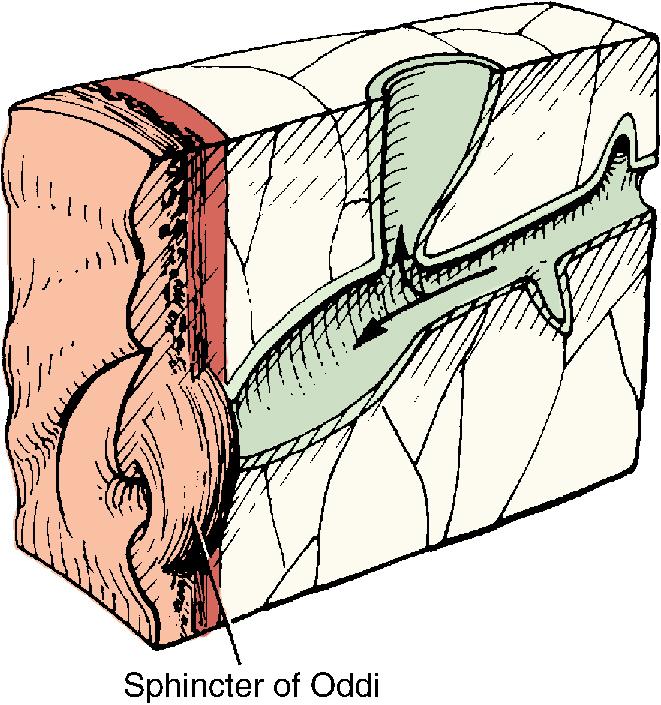

APBJ is a rare congenital anomaly that may result from failure of appropriate embryonic duct migration from the duodenum (see Chapter 1 ). It is present in 50% to 80% of patients with bile duct cysts. , , Yamao and colleagues defined the prevalence of APBJ as 0.3% in a Japanese cohort. The length of the common channel is variable; however, a length of greater than 8 mm has been suggested as a diagnostic criterion in addition to an intraductal amylase level exceeding 8000 IU/L. Sphincter of Oddi pressures may also be elevated in the setting of APBJ, further contributing to the pathogenesis of bile duct cysts. , APBJ has also been implicated in biliary tract cancer in the absence of a biliary cyst , (see Chapters 49 and 51 ).
APBJ has been associated with Type IA, IC, and IV bile duct cysts; therefore a significant proportion of bile duct cyst patients will lack this predisposing congenital anomaly. The absence of APBJ may be a true normal pancreaticobiliary junction, or secondary to inadequate resolution on diagnostic imaging, or exclusion by arbitrarily defined diagnostic criteria of the length of the common channel. A further detraction of the APBJ mechanism is that immature neonatal pancreatic acini are incapable of producing sufficient pancreatic enzymes to explain antenatally diagnosed bile duct cysts. , These observations make it difficult to invoke pancreatobiliary maljunction as a unifying etiologic factor.
Congenital cysts may develop from embryologic overproliferation of biliary epithelial cells during the cannulation phase of development, resulting in dilation. , , Viral infection of the fetus also has been implicated as a possible etiologic agent responsible for inducing the inflammatory changes that result in congenital bile duct cysts. An additional mechanism for congenital bile duct cyst formation is oligoganglionosis in the distal neck of the cyst. The reduction in ganglion cells in the narrow portion of the cyst wall may be the biliary equivalent of Hirschsprung disease of the colon. , 75 Whether this histologic finding accounts for the presence of bile duct cysts in the absence of an APBJ is unknown.
Acquired bile duct cysts in adults have been attributed to terminal ductal obstruction, including sphincter of Oddi dysfunction or stenosis. Pancreatobiliary reflux in the absence of an APBJ was documented in 81% of adults with bile duct cysts and previous cholecystectomy.
Type III bile duct cysts (choledochoceles) may arise embryologically as duodenal duplications that involve the ampulla. Alternatively, increasing evidence has suggested they are acquired. Mechanisms include inflammation of the papilla leading to obstructive dilation of the intramural CBD as well as sphincter of Oddi dysfunction or stenosis, with the increased sphincter pressure resulting in cystic dilatation. , , Given the variety of proposed pathogeneses and wide range of age at presentation, it is plausible that both congenital and acquired forms of choledochocele exist.
Caroli disease and syndrome are unique from the other bile duct cysts. The pathogenesis may be secondary to disruption or cessation of remodeling of the ductal plate during development of the intrahepatic bile ducts. The molecular basis is incompletely understood and has been posited to result from the gene implicated in autosomal recessive polycystic kidney disease.
Bile duct cysts are uncommon, with fewer than 5000 cases reported. , The incidence ranges from 1 in 100,000 to 1 in 150,000 individuals in Western countries to 1 in 1000 in certain parts of Asia. , , The incidence has been reported as great as 1 in 13,500 births in the United States and 1 in 15,000 births in Australia. Estimates of the actual clinical incidence range from 1 in 13,000 to 1 in 2 million patients, and biliary cysts account for approximately 1% of all benign biliary disease. , An elevated geographic incidence has been appreciated in Japan, , , where between one-half and two-thirds of reported cases have occurred. , Although the number of reported cases has increased recently, this finding probably reflects advances in diagnosis through improvements in hepatobiliary imaging rather than a true increase in incidence.
A female preponderance among patients with bile duct cysts is well known. Regardless of cyst type, the female to male ratio is 3 to 4:1. , , , The current pathogenesis of bile duct cysts has not implicated sex hormones or congenital intrauterine endocrine disturbances as possible factors, and the explanation for this finding is unknown.
Bile duct cysts often remain asymptomatic for years. Indeed, clinical presentation that occurs initially in adulthood occurs in nearly 25% of patients. , , Diagnosis may be an incidental finding on imaging studies for unrelated processes. If symptomatic, bile duct cysts usually present with symptoms mimicking calculous biliary tract disease, regardless of cyst type. The classic triad of symptoms includes abdominal pain, jaundice, and a palpable mass, and it is more common in children than adults. The triad of symptoms is observed in approximately 25% of adults; however, approximately 85% of children will have at least two features of the triad. , ,
Symptoms typically are intermittent, nonspecific, and vague. They include recurrent epigastric or right hypochondrial pain, abdominal tenderness, fever, and mild jaundice. Pain may radiate to the right infrascapular region or to the midback. If present, it generally persists for hours. Patients also may report nausea, vomiting, anorexia, pruritus, and weight loss. Biliuria precedes the onset of clinical jaundice. Abdominal pain or discomfort can be overshadowed by signs of cholangitis, such as fever and rigors. An abdominal mass is rare in adults; however, if a mass is present, cyst-associated malignancy must be strongly suspected (see Chapter 51 ).
The development of nonmalignant complications of bile duct cysts will contribute to clinical presentation. Complications include stone disease (cystolithiasis, cholelithiasis, cholecystitis, choledocholithiasis, and hepatolithiasis; see Chapters 33 and 39 ), cholangitis (see Chapter 43 ), acute and chronic pancreatitis (see Chapters 55 and 57 ), intraperitoneal rupture of the bile duct cyst, intussusception, gastric outlet obstruction, secondary biliary cirrhosis and hemorrhage from cyst erosion, and portal hypertension following development of cirrhosis, portal vein thrombosis, or mechanical compression of the portal vein by the cyst. , , Spontaneous intraperitoneal rupture has been reported in 1% to 12% of patients. , These patients will present with acute-onset abdominal pain, signs of peritonitis, and sepsis.
Complications that arise from all subtypes of bile duct cysts often result from bile stasis, stone formation, recurrent infection, and inflammation. Dilated cysts as well as distal obstruction in the setting of strictures, stenosis, and sphincter of Oddi dysfunction contribute to proximal bile stasis, resulting in stone and sludge formation and secondary bile infection. Stone and protein plug development in the distal CBD and pancreatic duct results in pancreatitis. Protein plug formation may be secondary to chronic inflammatory changes with the formation of an albumin-rich exudate or a result of hypersecretion of mucin in the setting of a dysplastic biliary epithelium.
Clinical pancreatitis is present in almost 30% of patients with bile duct cysts. In contrast to patients with cholangitis, patients with pancreatitis have more intense and prolonged epigastric pain and vomiting. Fever and jaundice are less prominent. Weight loss, although unusual, is noteworthy because almost 70% of adults with this finding will harbor an associated bile duct malignancy.
Approximately 15% of adults with type I or type IV bile duct cysts present overtly with secondary biliary cirrhosis or hepatic fibrosis from chronic biliary obstruction (see Chapter 74 ). Such patients typically have had multiple operations for complications of type I or IVa cysts or Caroli disease. Hepatomegaly and splenomegaly are common in patients with cirrhosis and portal hypertension. Hematemesis, melena, and ascites may accompany portal hypertension. Interestingly, other signs of chronic liver disease (muscle wasting, fatigue, spider angiomas, and pruritus) are uncommon. Liver failure is seen late in Caroli disease.
Accurate preoperative imaging of biliary cysts is key to adequately assess cyst extent, potentially identify malignancy, and define aberrant anatomy relevant for surgical planning ( Fig. 46.5 ) (see Chapter 16 ). Abdominal ultrasound, endoscopic ultrasonography (EUS), magnetic resonance cholangiopancreatography (MRCP), computed tomography (CT), direct cholangiography by ERCP (see Chapters 20 and 30 ), or percutaneous transhepatic cholangiography (PTC; see Chapters 20 and 31 ) are potential options for preoperative imaging ( Fig. 46.6 ). Current reviews of the diagnostic imaging modalities of bile duct cysts with representative images are referenced. ,
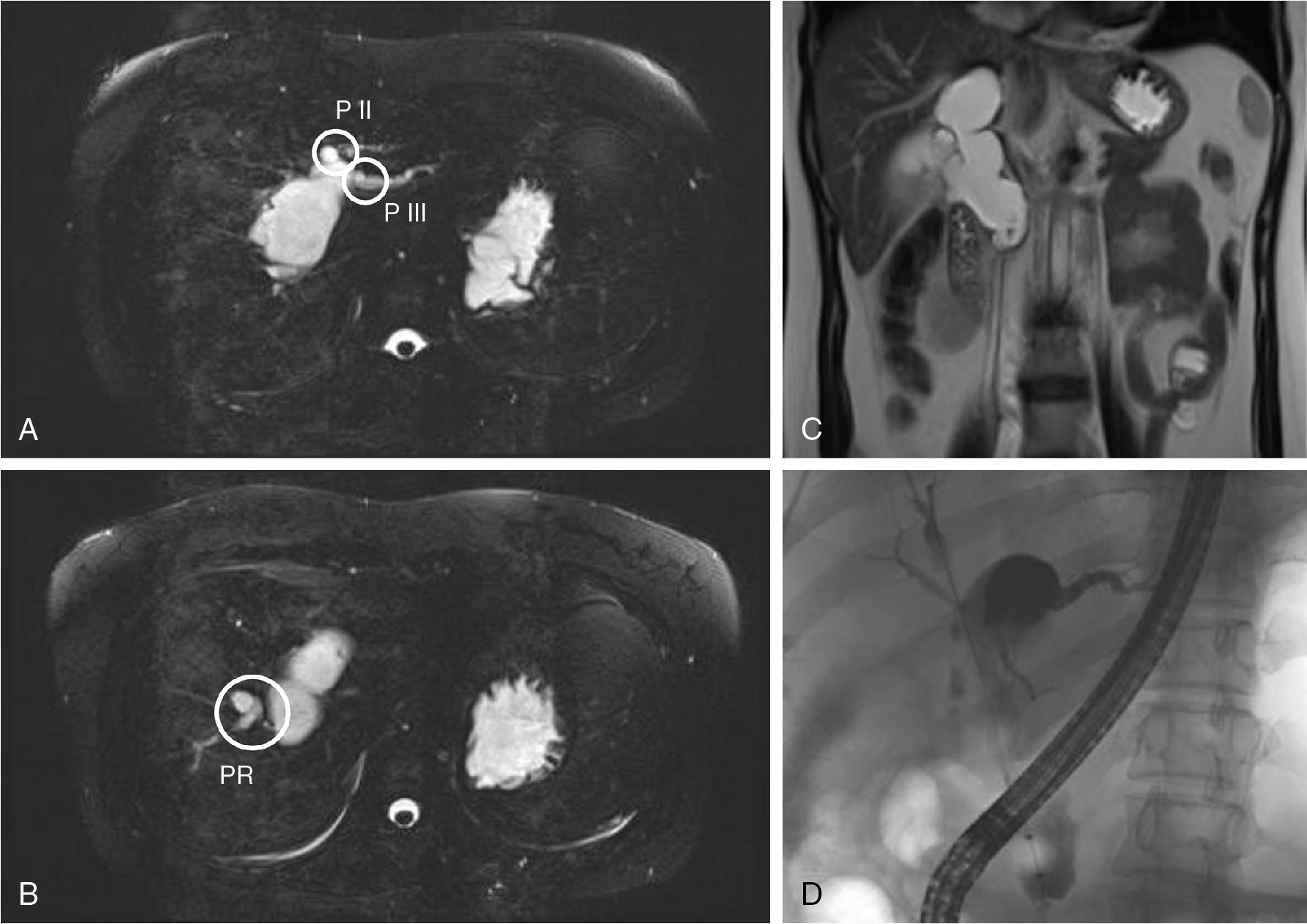
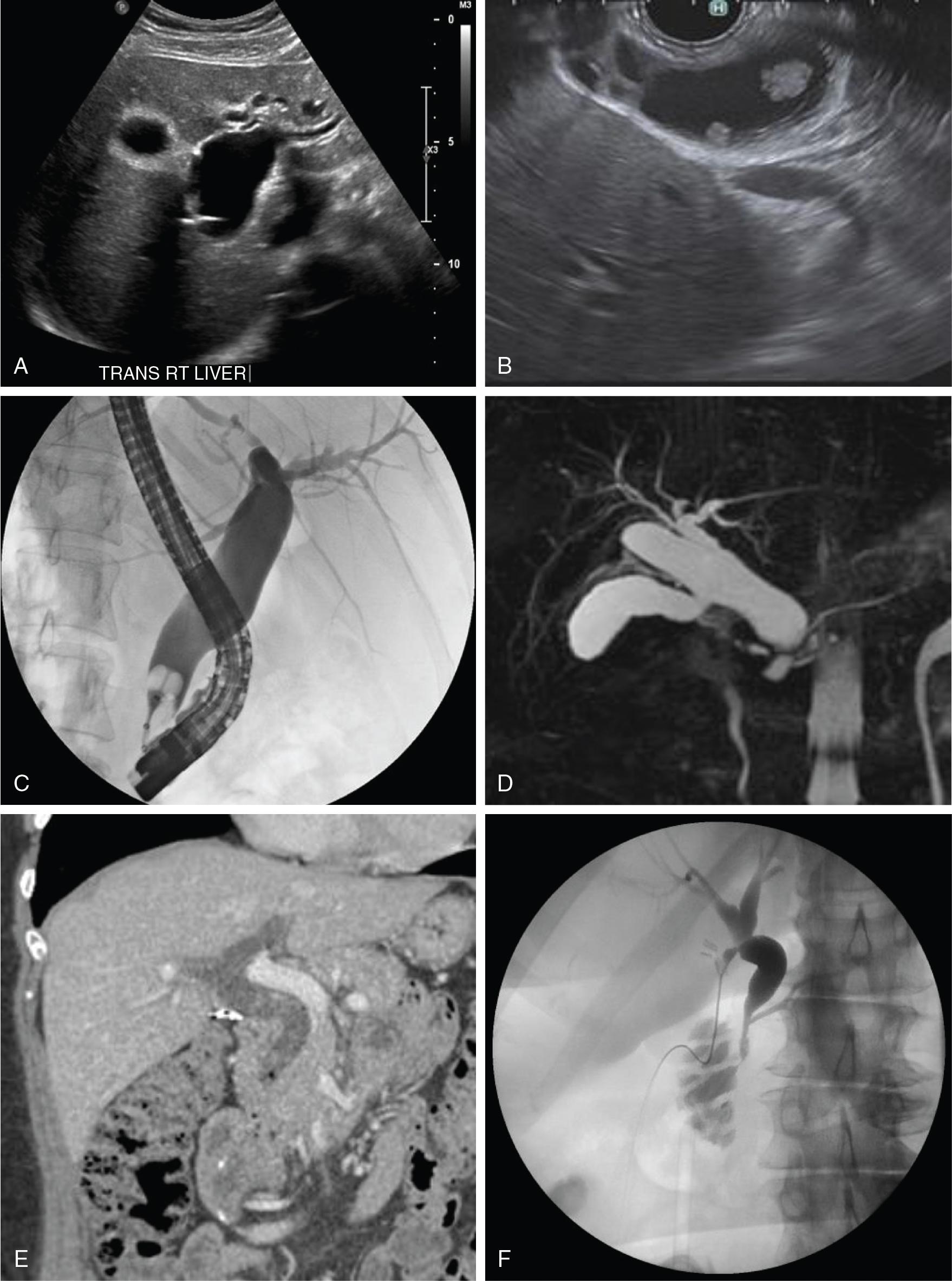
Both cholangiographic and dimensional imaging of the bile duct, liver, and pancreas are essential. Anatomic definition of the pancreatobiliary ductal junction is critical for operative management of bile duct cysts to avoid intraoperative damage to the pancreatic duct during cyst excision, to recognize stones impacted within the common channel or junction, and to exclude distal tumors. The angle of fusion between the distal bile duct and pancreatic duct varies widely and has led to a subclassification of cyst types. Typically, the bile duct cyst joins the pancreatic duct 2 to 4 cm proximal to the duodenum (see Figs. 46.2 and 46.3 ), resulting in a long common channel (ampulla). , , , Additionally, clear definition of the intrahepatic extent of the cyst is important (see Fig. 46.5 ). Detailed assessment of the liver including intrahepatic and extrahepatic bile ducts is of critical importance, as previous reports suggest that almost 80% of adults with bile duct cysts have liver-associated pathology. , , Although increased incidental detection of cysts certainly has decreased this rate, assessment for concomitant pathology remains indispensable for surgical planning.
Significant advancements in imaging and endoscopic modalities in recent years have resulted in different diagnostic approaches for bile duct cysts. Today, MRCP, CT, and ERCP have become the mainstays of diagnostic workup.
Ultrasound is frequently used as the initial diagnostic step in the workup of patients with biliary cysts. It remains a relevant noninvasive screening and surveillance modality. The detection rate of biliary cysts ranges from 71% to 97%. The sonographic features of bile duct cysts have been well defined for type I bile duct cysts and the variants of Caroli disease. , , , Ultrasound of type I cysts simply shows an irregular, hypoechoic segmental dilatation of the extrahepatic bile duct (see Fig. 46.6 ). Focal duct wall thickening or nodularity should arouse suspicion for cancer in an adult and requires further investigations. Ductal stones within the cyst are identified by typical echogenic features and acoustic shadowing. The absence of septations on ultrasound distinguishes bile duct cysts from extrahepatic cystadenomas. Although the sensitivity of ultrasound is excellent for cysts involving the bile duct proximal to the pancreas, it is limited in adults in identifying choledochoceles because of the frequency of bowel gas overlying the terminal CBD and the small size of these cysts. EUS is not limited by bowel gas or body habitus, and it allows biopsy if malignancy is suspected. Overall, EUS represents a useful, selective diagnostic adjunct (see Chapters 16 and 22 ).
Become a Clinical Tree membership for Full access and enjoy Unlimited articles
If you are a member. Log in here